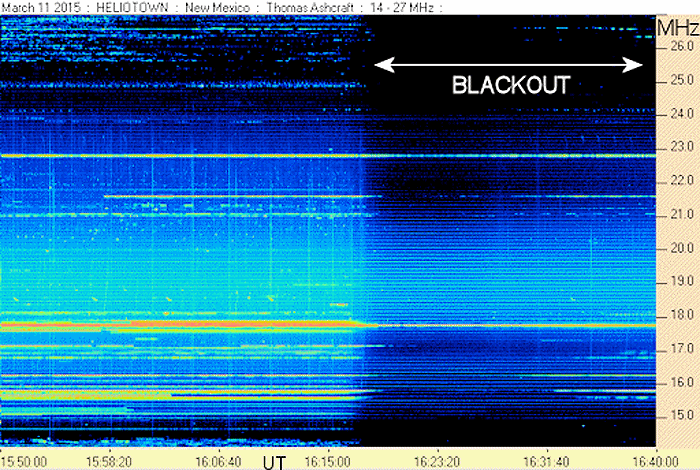.

NASA's Solar Dynamics Observatory captured an image of a mid-level solar flare on March 11, 2015, seen as a bright flash of light on the left side of the sun. Earth is shown for scale.
Image Credit: NASA/SDO
.
The sun emitted a significant solar flare, peaking at 12:22 p.m. EDT on March 11, 2015. NASA’s Solar Dynamics Observatory, which watches the sun constantly, captured an image of the event. Solar flares are powerful bursts of radiation. Harmful radiation from a flare cannot pass through Earth's atmosphere to physically affect humans on the ground, however -- when intense enough -- they can disturb the atmosphere in the layer where GPS and communications signals travel.
To see how this event may affect Earth, please visit NOAA's Space Weather Prediction Center at http://spaceweather.gov, the U.S. government's official source for space weather forecasts, alerts, watches and warnings.
This flare is classified as an X2.2-class flare. X-class denotes the most intense flares, while the number provides more information about its strength. An X2 is twice as intense as an X1, an X3 is three times as intense, etc.
Quelle: NASA
-
X2-FLARE AND RADIO BLACKOUT: All week long, sunspot AR2297 has been crackling with solar flares. Yesterday it produced a really big one. On March 11th at 16:22 UT (09:22 PDT), Earth orbiting-satellites detected an X2-class flare. The blast zone was larger than Earth tself.
Extreme ultraviolet radiation from the explosion ionized the upper layers of Earth's atmosphere, causing HF radio blackouts and other propagation effects on the dayside of our planet, particularly over the Americas: map.
In New Mexico, amateur radio astronomer Thomas Ashcraft was observing the sun using a wideband spectrograph when the flare occured. The radio blackout was obvious at every frequency from 15 MHz to 26 MHz:
-

"The X-flare scrambled the ionosphere thoroughly so that no decametric radio signals were supported in my part of the world," says Ashcraft. "The ionosphere started to reform after about fifteen minutes when stations began to reappear. (The stuff visible during the blackout was my own observatory electricity. Nothing exterior.)"
A coronal mass ejection (CME) was propelled into space by the explosion. However, we do not yet know if it will hit Earth. A glancing blow is possible on March 13th or 14th. Confirmation awaits the belated arrival of coronagraph data from SOHO.
Quelle: Spaceweather
5383 Views
